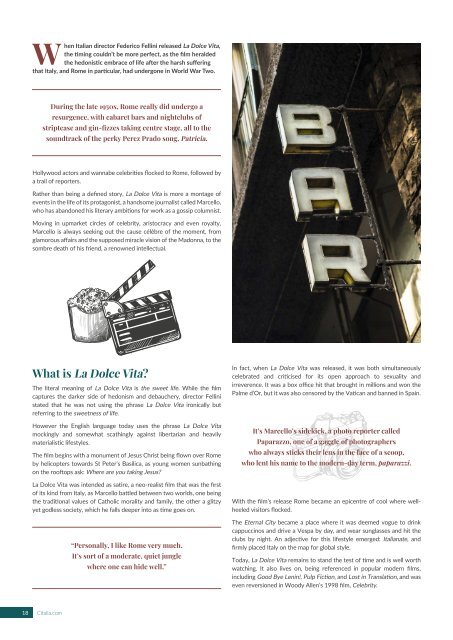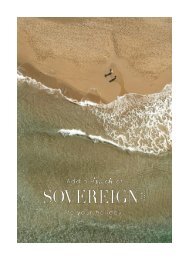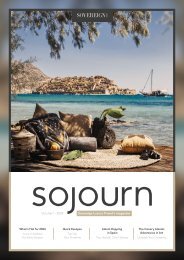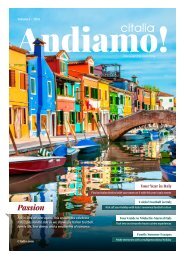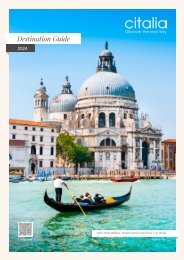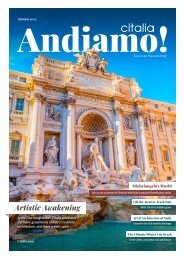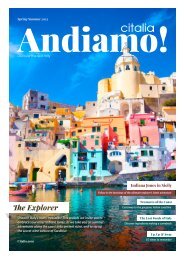Andiamo! | Citalia Magazine Autumn 2021
This season, we celebrate everything that the streets have to offer, not least because it’s Italy’s cities that can provide you with a perfect winter holiday. In our article, Secrets of Italy’s Streets, we’ll take you to the coolest urban neighbourhoods, and share with you some underground networks that are steeped in history. Italy’s cities bring with them an epic industrial past, which you can explore through automobile innovation with our feature, In the Hot Seat: Italian Cars. Make your next Citalia holiday extra special with our pick of Iconic Luxury Hotels. You can also receive some additional tips from our Personal Travel Planner Raggy Singh in Tailormaking Italy, and from one of our favourite guests, renowned archaeologist Dr Holley Martlew in Digging Up Italy. We continue our Book with Confidence guarantee so that you can book your holiday with a refund guarantee while still able to make any changes to your future bookings with ease. Andiamo!
This season, we celebrate everything that the streets have to offer, not least because it’s Italy’s cities
that can provide you with a perfect winter holiday.
In our article, Secrets of Italy’s Streets, we’ll take you to the coolest urban neighbourhoods, and share
with you some underground networks that are steeped in history.
Italy’s cities bring with them an epic industrial past, which you can explore through automobile innovation with our feature, In the Hot Seat: Italian Cars.
Make your next Citalia holiday extra special with our pick of Iconic Luxury Hotels. You can also receive
some additional tips from our Personal Travel Planner Raggy Singh in Tailormaking Italy, and from one of our favourite guests, renowned archaeologist Dr Holley Martlew in Digging Up Italy.
We continue our Book with Confidence guarantee so that you can book your holiday with a refund guarantee while still able to make any changes to your future bookings with ease.
Andiamo!
Create successful ePaper yourself
Turn your PDF publications into a flip-book with our unique Google optimized e-Paper software.
When Italian director Federico Fellini released La Dolce Vita,<br />
the timing couldn’t be more perfect, as the film heralded<br />
the hedonistic embrace of life after the harsh suffering<br />
that Italy, and Rome in particular, had undergone in World War Two.<br />
During the late 1950s, Rome really did undergo a<br />
resurgence, with cabaret bars and nightclubs of<br />
striptease and gin-fizzes taking centre stage, all to the<br />
soundtrack of the perky Perez Prado song, Patricia.<br />
Hollywood actors and wannabe celebrities flocked to Rome, followed by<br />
a trail of reporters.<br />
Rather than being a defined story, La Dolce Vita is more a montage of<br />
events in the life of its protagonist, a handsome journalist called Marcello,<br />
who has abandoned his literary ambitions for work as a gossip columnist.<br />
Moving in upmarket circles of celebrity, aristocracy and even royalty,<br />
Marcello is always seeking out the cause célèbre of the moment, from<br />
glamorous affairs and the supposed miracle vision of the Madonna, to the<br />
sombre death of his friend, a renowned intellectual.<br />
What is La Dolce Vita?<br />
The literal meaning of La Dolce Vita is the sweet life. While the film<br />
captures the darker side of hedonism and debauchery, director Fellini<br />
stated that he was not using the phrase La Dolce Vita ironically but<br />
referring to the sweetness of life.<br />
However the English language today uses the phrase La Dolce Vita<br />
mockingly and somewhat scathingly against libertarian and heavily<br />
materialistic lifestyles.<br />
The film begins with a monument of Jesus Christ being flown over Rome<br />
by helicopters towards St Peter’s Basilica, as young women sunbathing<br />
on the rooftops ask: Where are you taking Jesus?<br />
La Dolce Vita was intended as satire, a neo-realist film that was the first<br />
of its kind from Italy, as Marcello battled between two worlds, one being<br />
the traditional values of Catholic morality and family, the other a glitzy<br />
yet godless society, which he falls deeper into as time goes on.<br />
“Personally, I like Rome very much.<br />
It’s sort of a moderate, quiet jungle<br />
where one can hide well.”<br />
In fact, when La Dolce Vita was released, it was both simultaneously<br />
celebrated and criticised for its open approach to sexuality and<br />
irreverence. It was a box office hit that brought in millions and won the<br />
Palme d’Or, but it was also censored by the Vatican and banned in Spain.<br />
It’s Marcello’s sidekick, a photo reporter called<br />
Paparazzo, one of a gaggle of photographers<br />
who always sticks their lens in the face of a scoop,<br />
who lent his name to the modern-day term, paparazzi.<br />
With the film’s release Rome became an epicentre of cool where wellheeled<br />
visitors flocked.<br />
The Eternal City became a place where it was deemed vogue to drink<br />
cappuccinos and drive a Vespa by day, and wear sunglasses and hit the<br />
clubs by night. An adjective for this lifestyle emerged: Italianate, and<br />
firmly placed Italy on the map for global style.<br />
Today, La Dolce Vita remains to stand the test of time and is well worth<br />
watching. It also lives on, being referenced in popular modern films,<br />
including Good Bye Lenin!, Pulp Fiction, and Lost in Translation, and was<br />
even reversioned in Woody Allen’s 1998 film, Celebrity.<br />
18 <strong>Citalia</strong>.com


